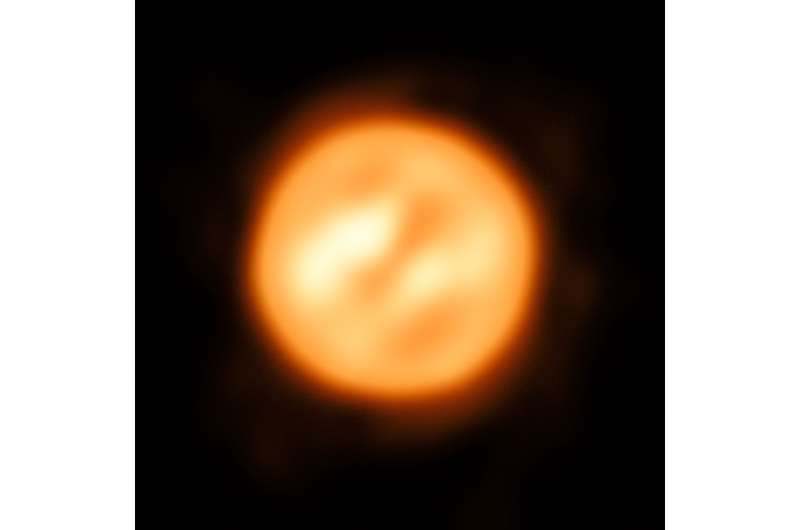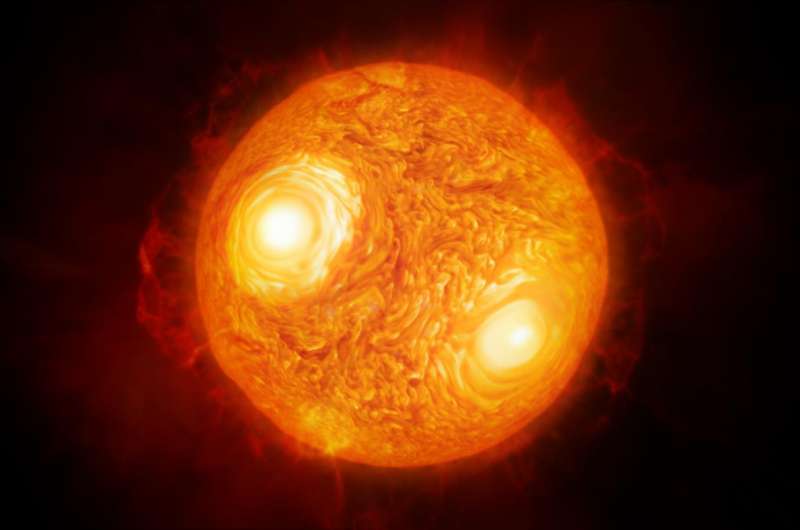August 17, 2017 report
Closer look at red supergiant Antares suggests convection not enough to remove surface material

(Phys.org)—A trio of researchers with Universidad Católica del Norte and the Max-Planck-Institut für Radioastronomie has found evidence that suggests that convection alone cannot account for the amount of material that is pulled from the surface of a red supergiant. In their paper published in the journal Nature, K. Ohnaka, G. Weigelt and K.-H. Hofmann describe their study of the supergiant Antares, what they found and why they now believe there is an unknown force pulling some parts of the star's surface into space. Gail Schaefer with Georgia State University offers a News & Views piece on the work done by the team in the same journal issue.
The red supergiant Antares is familiar to stargazers as the heart of the scorpion in the Scorpius constellation. Prior research has found it to be a red supergiant with a mass approximately 15 times that of our sun—it is also at the end stages of its existence. Prior research has also shown that red giants have atmospheres that extend far from their surface—Antares, for example, has some regions that would extend all the way to Mars if it were in our solar system. The prevailing theory explaining such far-reaching regions has been convection cells carrying the material away from the star. But now, that theory might have to be changed as the researchers with this new effort have found evidence that suggests convection alone could not lift as much material from Antares as they have measured.
To gain a better understanding of what is happening with Antares, and by extension other red giants, the team used the Very Large Telescope Interferometer at the European Southern Observatory based in Chile. In addition, they used a device called AMBER, which combines the light from three telescopes into one, creating a virtual telescope with an 82-meter-diameter lens. The team conducted a spectral analysis of the stars' upper atmosphere and created what they describe as a "dopplergram" of the star showing which way parts of the star were moving and in which direction.

The researchers found that the density of the material being moved and its extent were higher than current models predict, which, they note, suggests that there is likely an unknown force at play.
More information: Vigorous atmospheric motion in the red supergiant star Antares, Nature 548, 310–312. nature.com/articles/doi:10.1038/nature23445
Abstract
Red supergiant stars represent a late stage of the evolution of stars more massive than about nine solar masses, in which they develop complex, multi-component atmospheres. Bright spots have been detected in the atmosphere of red supergiants using interferometric imaging. Above the photosphere of a red supergiant, the molecular outer atmosphere extends up to about two stellar radii. Furthermore, the hot chromosphere (5,000 to 8,000 kelvin) and cool gas (less than 3,500 kelvin) of a red supergiant coexist at about three stellar radii. The dynamics of such complex atmospheres has been probed by ultraviolet and optical spectroscopy. The most direct approach, however, is to measure the velocity of gas at each position over the image of stars as in observations of the Sun. Here we report the mapping of the velocity field over the surface and atmosphere of the nearby red supergiant Antares. The two-dimensional velocity field map obtained from our near-infrared spectro-interferometric imaging reveals vigorous upwelling and downdrafting motions of several huge gas clumps at velocities ranging from about −20 to +20 kilometres per second in the atmosphere, which extends out to about 1.7 stellar radii. Convection alone cannot explain the observed turbulent motions and atmospheric extension, suggesting that an unidentified process is operating in the extended atmosphere.
Journal information: Nature
© 2017 Phys.org





















